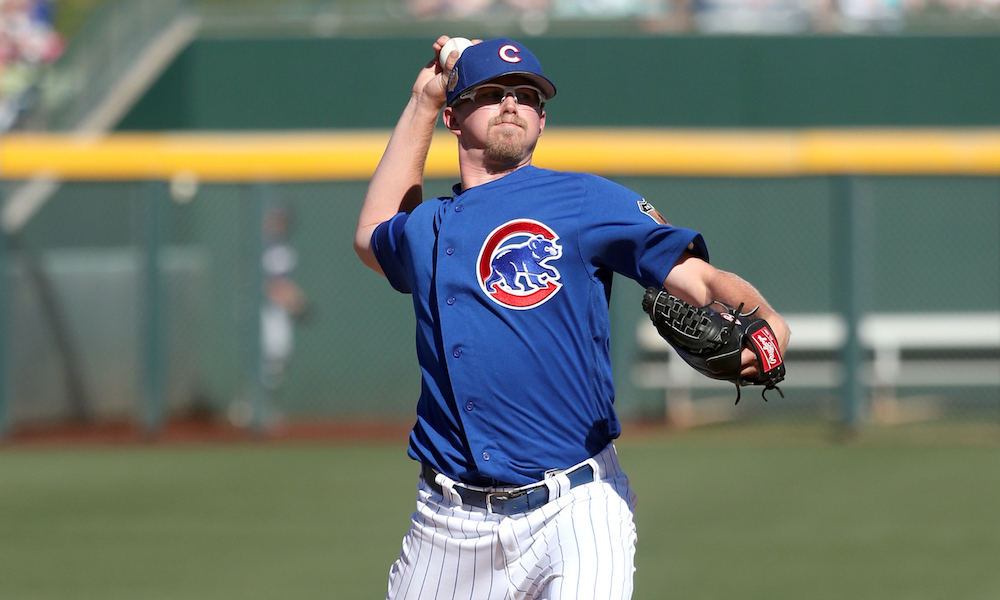Feature Photo: Pierce Johnson, RHP, Cubs
 Once a top pitching prospect in the Chicago Cubs’ farm system, right-hander Pierce Johnson had been struggling with injuries for several seasons when he was approached by the front office last July about a move to the bullpen.
Once a top pitching prospect in the Chicago Cubs’ farm system, right-hander Pierce Johnson had been struggling with injuries for several seasons when he was approached by the front office last July about a move to the bullpen.
The litany of ailments – separately a hamstring and left calf strain in 2014, a back strain in 2015, and then bad luck come-backer that hit his throwing arm in his first 2016 start and a lat strain last season – that had plagued him since 2014 had by then hindered his performance on the mound significantly. After mowing down batters at a strikeout-per-inning clip through his first two years as a pro, this cavalcade of other minor injuries kept Johnson stuck in a back-and-forth from the mound to the disabled list for three seasons while he was with Class A Kane County in 2014, Double-A Tennessee in 2015, and Triple-A Iowa most recently.
By July of 2016, Johnson’s SO/9 had dropped to as low as 6.8, and his ERA had soared to 8.02 on July 26, so questions began to be raised about his future as a starting pitcher. It was at that time that the Cubs suggested that he move to the bullpen.
But at the time, the idea of moving to relief was not presented as an effort to improve his performance, or as a means of shielding him from injury. Instead, it was about preparing Johnson to potentially be a part of the Cubs’ final stretch before last year’s postseason run to the World Series title.
“They told me that our starting rotation was very solidified, and my stuff could work in the pen really well. The thought was that I could make a contribution in September.” Johnson shared in a recent phone interview.
The Cubs’ starting rotation of Jon Lester (LHP), Jake Arrieta (RHP), Kyle Hendricks (RHP), John Lackey (RHP), and Jason Hammel (RHP, now with the Royals) was, of course, a hard one to crack even in the waning months of the regular season, when starters are often wearing down and in need of a break, so Johnson said he was willing to embrace a new role if it meant helping the team.

Pierce Johnson, RHP, Cubs (Photo by John Arguello)
Though the September call-up never did come in 2016, Johnson did get his introduction to the bullpen in Triple-A Iowa. He made 11 relief appearances with a 3.22 ERA over 22 1/3 innings with an eye-popping 35 strikeouts that unfortunately paired with 13 walks. He had an impressive 1.80 GO:AO ratio and held opponents to a .176 BAA, which were clearly encouraging signs. The transition to the pen left Johnson enthusiastic about a role he had never previously held, so he spent the 2016 offseason working on adjusting to, and redefining, how he sees himself as a pitcher.
“Starting is my first love, but I told myself I was going to jump in with both feet and really see what I could do.” Johnson said.
During the winter, this meant developing an understanding of the mental aspects of relieving, and also what he needs to do to stay healthy, an area where Johnson says he has learned a great deal from the injury struggles of the past few seasons.
“I was a really skinny guy coming out of college, and I put on weight after I got drafted. I had to learn my body, learn to take care of myself, and learn what works for me to maintain flexibility” Johnson said. He has shifted his workouts from putting on weight to staying agile, so that the 6-foot-3, 200 pound 25-year-old has hopefully reached the point where he can stay healthy.
This spring, he had the chance to pick the brains and receive words of encouragement from the likes of Mike Montgomery (LHP), now primarily a reliever but also a part-time starter for the Cubs, and Wade Davis (RHP) while he was participating in spring training in the Cactus League.
Along with these two, Johnson said the chance to work with bullpen catchers Lester Strode and Chad Noble had a big impact as well. Noble, in particular, provided encouraging insights about how the ball was coming out of Johnson’s hand during spring training.
“With all of these guys together and picking their brains, that’s helped me to where I am now.” Johnson said.
Having the opportunity to work with pitchers like Montgomery and Davis and coaches like Noble and Strode left Johnson feeling energized about starting the new season as a reliever, but his confidence was also boosted by the change he noticed in his pitches during spring training.
“It definitely sharpened some of my stuff. My fastball has gotten better, and my breaking stuff is sharper.” Johnson said.
He brings a repertoire of a fastball that runs in on right-handed batters that can be hard to command, a 10-to-4 curveball that is effective against hitters on both sides of the plate, and a changeup that still needs refinement, though it has natural drop. The fastball, in particular, is where Johnson says he saw the most notable change.
“The fastball has taken off since the move. The hitters are seeing it differently, and I’m seeing some different swings from them on it. It’s got a little more giddy-up on it.” Johnson said.
His heater, which had previously come in the low 90s, touched as high as 96 mph in shorter spring training stints, according to 2080’s John Arguello, and has been clocked at 94-to-95 mph in his first few appearances in the Pacific Coast League for the Triple-A Iowa Cubs. Johnson has made six relief appearances on the season, and he has allowed just 2 earned runs (both in an April 10, one-inning outing against Oklahoma City, a 5-2 loss). Otherwise, he has 13 strikeouts and six walks over 7 1/3 innings and has given up only four hits. Those six walks in 7 1/3 innings mean control does still remain an issue, and this is likely his remaining hurdle that’s standing in the way of a call-up.
Even with the early success, the shift to the bullpen is still in its nascent stages, and Johnson is open about the fact that he is still learning.
“In the bullpen you really have to give one hundred percent every day—you have to turn the page and forget what you don’t want to remember. I’m still working on it; it has been a trial by fire.” Johnson said.
Notably, Johnson shared these thoughts just hours after a particularly rough spring training appearance with the big league club, so this forgetting was something he was putting into practice even as he reflected on the change in his identity as a pitcher.
“As a starter, you know you have four days to iron something out, and you have to think about facing the order two or three times, but as a reliever, you just have that attack mentality. You’re coming in for an inning, maybe just a batter. In some ways, it’s easier to throw everything at once. You just throw the kitchen sink at them.” Johnson said.
After just the first couple of weeks of the minor league season, Johnson has seen early success coming out of the bullpen. The September call-up may not have come last season, but he knows what it will take to crack the bullpen in Chicago this summer, and he knows the formula is pretty simple.
“I have to be consistent. I have to throw strikes and get outs. They want someone they can rely on to get the job done, and I want them to be confident in me.” Johnson said.
Though the Cubs’ reliever corps is well stocked, they have thus far just one sturdy left-handed reliever in Montgomery, and Johnson’s reverse splits (lefties are hitting .167 against him, righties .222), could mean that he might have the opportunity in Chicago to function like a situational reliever against left-handed batters.
Not only that, but the Cubs’ bullpen has already shown that they are not impervious to bad outings. Namely, a pair of blown games against the Pittsburgh Pirates on April 15 and 16 when they collectively surrendered 11 runs between the two games, an 8-7 loss on Saturday where the bullpen blew a 6-3 lead thanks to a five-run seventh inning, and a 6-1 beating the following day, when Jon Lester’s seven scoreless inning were wasted when the bullpen gave up a trio of runs in both the eighth and ninth innings – the kinds of games that might prompt the parent club to look for more reliable relief arms for mid-season tryouts, and to test their effectiveness prior to this year’s postseason run.
Johnson hopes he’s in the mix when the decision needs to be made. Though his control issues remain a clear point of development this season, he’s confidently transitioned to his new relief role, and his early results at Triple-A Iowa are showing that he’s almost ready for his shot.



